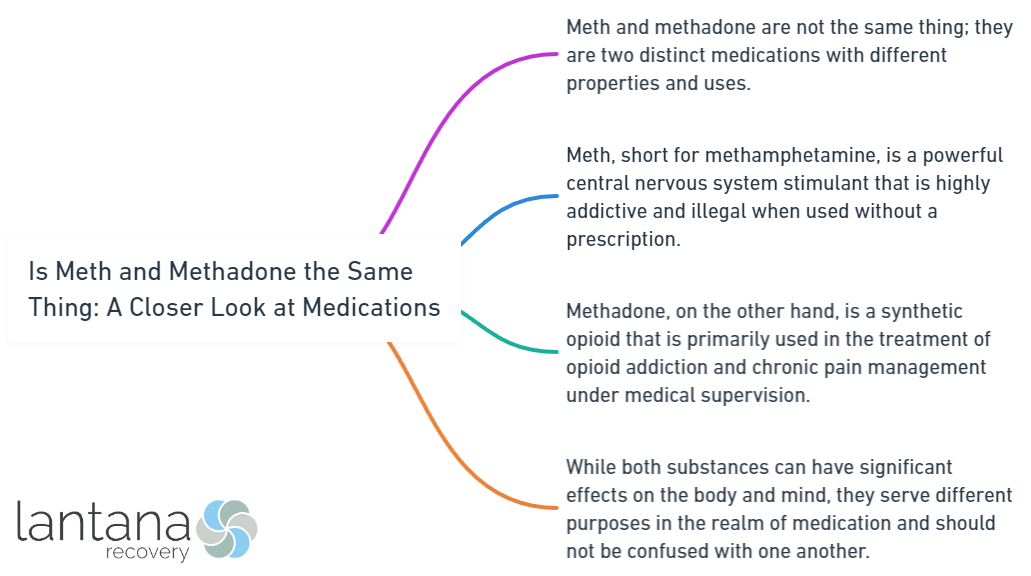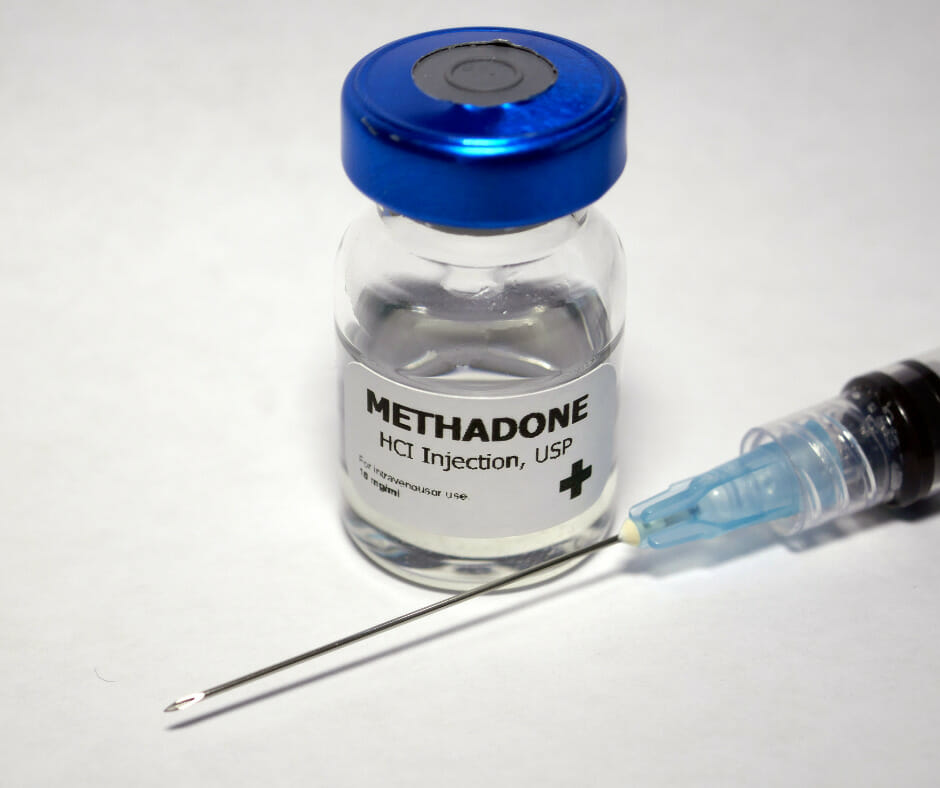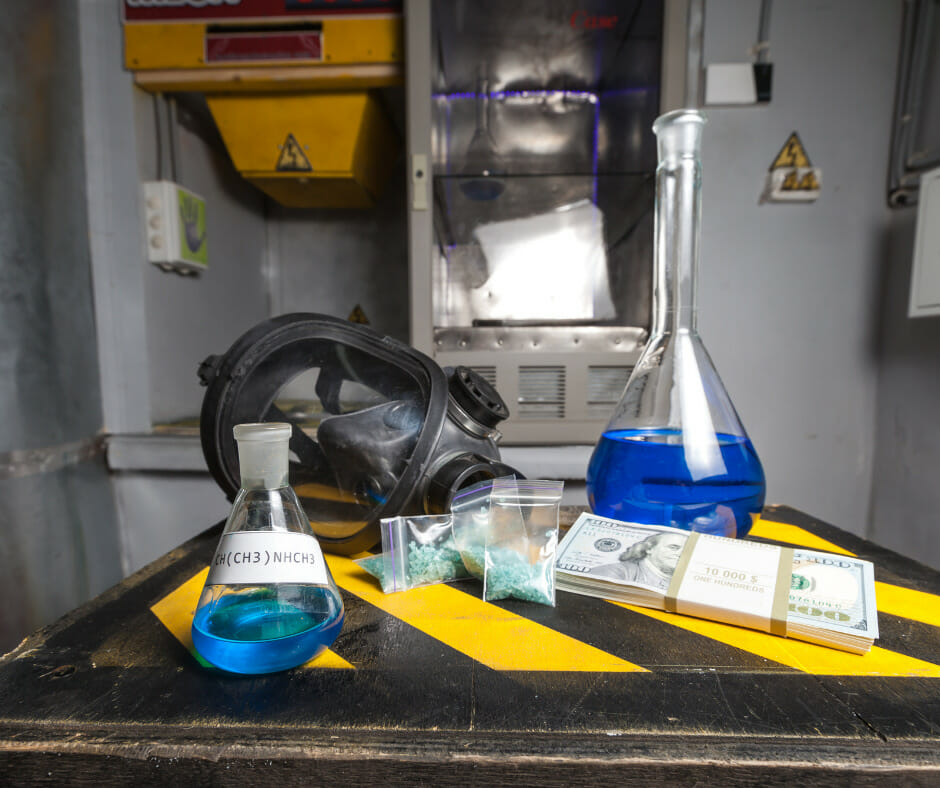Meth and methadone are two distinct substances that are often confused due to their similar names. In this article, we will take a closer look at these medications to understand their differences, uses, and effects.
Meth, also known as methamphetamine, is a powerful stimulant drug that affects the central nervous system. It is a highly addictive substance commonly used as a recreational drug. We will explore what methamphetamine is, how it is used, and the short-term and long-term effects it can have on individuals.
On the other hand, methadone is a medication used in addiction treatment. It falls under the category of opioid replacement therapies and is primarily used to manage heroin addiction and withdrawal symptoms. We will delve into the uses of methadone in addiction treatment, the benefits it offers, and the potential risks associated with its use.
While the names may sound similar, it is important to understand that meth and methadone are not the same thing. We will explore the differences between the two medications and highlight their individual characteristics. we will also touch upon any similarities that may exist between meth and methadone.
By examining these medications closely, we aim to enhance your understanding of the distinct properties of meth and methadone, their purposes, and the various uses they serve. Furthermore, we will discuss the legal status of both substances to provide a comprehensive overview of their regulatory framework.
Join us as we dive into this topic and gain a deeper insight into the world of meth and methadone, shedding light on their respective roles and implications.

What is Meth?
Methamphetamine, also known as meth, is a highly addictive central nervous system stimulant. It has a similar effect to amphetamine, but it has a stronger impact on the central nervous system. Meth is commonly found as a white, odorless powder that can be dissolved in water or alcohol. Additionally, it can be encountered in the form of clear or bluish crystals called “ice” or “crystal meth“.
Niall Gabltraith writes in The methamphetamine problem that similar to other stimulants like cocaine and amphetamine, it generates sensations of euphoria, heightened alertness, and boosted energy. However, in contrast to cocaine, a solitary dose of methamphetamine maintains these impacts for an extended duration of time. Moreover, it influences the brain’s reward system, contributing to the high potential for addiction. Meth can be consumed by smoking, snorting, injecting, or taking it orally. The duration of its effects varies, lasting from a few hours to several days, depending on the method of consumption.
Using meth can have severe consequences on both physical and mental health. It can result in weight loss, dental issues, skin sores, and cardiovascular complications. The prolonged and excessive use of meth can also lead to cognitive impairments and psychological problems such as anxiety, paranoia, and psychosis.
It is crucial to understand that meth is illegal in most countries due to the significant risks it poses for abuse and health. It greatly impacts an individual’s well-being, as well as their overall quality of life. Seeking assistance from healthcare professionals and support groups is essential for overcoming meth addiction and promoting long-term recovery.
Understanding Methamphetamine
Methamphetamine, commonly known as meth, is a powerful and addictive stimulant drug. Understanding methamphetamine is crucial to comprehend its risks and effects. Here is a list to help you understand methamphetamine:
1. Production: Meth is produced in illegal laboratories using chemicals like pseudoephedrine found in some cold medications.
2. Form: Methamphetamine can be in the form of powder, crystals, or tablets. It can be smoked, injected, swallowed, or snorted.
3. Effects: Methamphetamine produces intense effects like increased energy and euphoria, decreased appetite, increased heart rate, and dilated pupils. It can also cause paranoia, hallucinations, aggressive behavior, and long-term damage to the brain and body.
4. Health Risks: Prolonged methamphetamine use can lead to serious health risks such as addiction, cardiovascular problems, severe dental issues (known as “meth mouth”), memory loss, and mental health problems like anxiety, depression, and psychosis. Signs of methamphetamine abuse include an initial powerful rush, a ‘meth crash’ when the substance wears off, and serious long-term health effects.
5. Legal Status: Methamphetamine is classified as a Schedule II controlled substance in the United States due to its high potential for abuse and limited medical usefulness.
Understanding methamphetamine is essential to make informed decisions and avoid serious consequences. If you or someone you know struggles with methamphetamine addiction, seek professional help immediately to overcome addiction and cultivate a healthier lifestyle.
How is Meth Used?
Methamphetamine, also known as meth, is a highly addictive stimulant that impacts the central nervous system. Meth can be utilized in various ways.
1. Smoking: Meth can be heated and vaporized, then inhaled through a glass pipe or foil. This technique rapidly introduces the drug into the bloodstream and induces a potent high.
2. Snorting: Meth powder can be crushed and inhaled through the nose. The drug is absorbed through the nasal passages and enters the bloodstream, although the effects may be less intense than smoking.
3. Injecting: Meth can be dissolved in water and directly injected into the bloodstream using a needle. This approach delivers the drug quickly and can trigger an immediate and intense rush of euphoria.
4. Swallowing: Some individuals may opt to ingest meth orally by swallowing pills or capsules. This method results in slower absorption into the bloodstream and may lead to a less intense high compared to smoking or injecting.
It’s essential to note that meth use carries significant risks and can have severe consequences, both in the short-term and long-term. The effects of meth can encompass increased energy, decreased appetite, euphoria, elevated heart rate, elevated blood pressure, and even psychosis. Prolonged use can lead to addiction, cognitive impairment, dental issues, and harm to various organs, including the brain. Seeking professional assistance and treatment is crucial for individuals grappling with methamphetamine addiction.
Short-term and Long-term Effects of Methamphetamine Abuse
The short-term and long-term effects of meth on physical and mental health are highly significant. Methamphetamine, commonly referred to as meth, acts by increasing the release of dopamine and inhibiting its reuptake, resulting in feelings of euphoria and heightened energy levels. Users often experience heightened alertness, reduced appetite, and intense pleasure. Physically, meth can cause an increase in heart rate, elevated blood pressure, and dilated pupils. It can also lead to insomnia, anxiety, paranoia, and aggressive behavior.
It is crucial to be aware of overdose symptoms such as unusual sleepiness, weakness, or breathing problems, and to seek medical help immediately if these occur.
Continued use of meth can lead to addiction and profound changes in the brain. Chronic meth use is associated with severe dental problems, commonly known as “meth mouth,” which occurs due to both poor oral hygiene and the corrosive properties of the drug. Weight loss, skin sores, and a weakened immune system are also commonly experienced by meth users. Additionally, cognitive impairments such as memory loss, decreased attention span, and difficulties with decision-making can arise from long-term meth use. Furthermore, individuals who engage in prolonged meth use are at a higher risk of developing anxiety disorders, depression, and psychosis.
It is imperative to recognize that prolonged methamphetamine use can result in irreversible brain damage and long-lasting cognitive and emotional difficulties.

What is Methadone?
Methadone, a powerful medication, plays a crucial role in addiction treatment. In this section, we’ll unravel the mysteries surrounding methadone and discover its true nature. We’ll delve into its various uses in addiction treatment and shed light on the benefits and risks associated with this medication. Brace yourself for an eye-opening journey into the world of methadone, as we uncover its potential impact in helping individuals overcome addiction. Methadone is also FDA-approved for pain management, providing a comprehensive treatment plan that includes counseling and other behavioral health therapies.
Uses of Methadone in Addiction Treatment
The uses of methadone in addiction treatment are significant in helping individuals recover from opioid addiction. Here are some key uses of methadone in addiction treatment:
- Methadone maintenance treatment: Methadone is commonly used as a maintenance medication for individuals with opioid dependence as part of a comprehensive treatment program. It stabilizes their opioid receptors, reducing cravings and withdrawal symptoms, and allowing individuals to focus on recovery.
- Reduction of withdrawal symptoms: Methadone alleviates withdrawal symptoms associated with opioid withdrawal. It helps individuals gradually taper off opioids, minimizing discomfort during detoxification.
- Prevention of relapse: Methadone treatment effectively prevents relapse among individuals with opioid addiction. By reducing cravings and withdrawal symptoms, it helps individuals resist the urge to seek opioids.
- Improvement of overall functioning: Methadone treatment addresses the physical aspects of addiction and improves overall functioning. It allows individuals to regain stability, maintain employment, and engage in meaningful relationships.
- Reduction of risky behaviors: Methadone treatment reduces risky behaviors associated with opioid addiction, such as needle sharing and illegal activities to obtain drugs. This helps decrease the spread of HIV, Hepatitis C, and other infections.
Benefits and Risks of Methadone: Withdrawal Symptoms
“Methadone’s efficacy in reducing morbidity and mortality related to opioid use disorder is supported by a wealth of evidence” (The relationship between crystal methamphetamine use and methadone retention in a prospective cohort of people who use drugs, Mackay et al., 2021.) The benefits and risks of methadone include:
- Reduces withdrawal symptoms: Methadone is used in addiction treatment to manage withdrawal symptoms when someone stops using opioids. It alleviates physical and psychological discomfort associated with withdrawal, making it easier to stop using opioids.
- Blocks the effects of opioids: Methadone binds to opioid receptors in the brain, blocking the pleasurable effects of opioids. This reduces cravings and prevents relapse in individuals recovering from opioid addiction.
- Long-lasting effects: Methadone has a long duration of action, allowing once-a-day administration for stable levels in the system. This eliminates frequent doses and provides consistent relief from withdrawal symptoms.
- Supports successful treatment outcomes: Studies show that methadone maintenance treatment is associated with reduced overdose deaths, reduced criminal activity, improved social functioning, and better overall treatment outcomes for individuals with opioid addiction.
- Potential for misuse and addiction: While methadone is used to treat opioid addiction, it can still be misused and lead to addiction. Close monitoring and adherence to prescribed doses minimize this risk.
- Possibility of side effects: Methadone can cause constipation, drowsiness, dizziness, and difficulty breathing. Proper medical supervision can manage these side effects, but they can impact daily functioning.
- Drug interactions:Methadone can interact with other medications like benzodiazepines, especially those affecting the central nervous system. Individuals taking methadone should inform their healthcare provider of all medications to avoid harmful interactions.
- Risk of overdose: Taking too much methadone can lead to overdose, especially without medical supervision or when combined with alcohol or benzodiazepines. The overdose risk is heightened with prolonged methadone use and when combined with stimulants like methamphetamine.

Are Meth and Methadone the Same Thing?
Meth and methadone are not the same thing. While meth is an illegal and addictive stimulant drug that affects the central nervous system and is associated with numerous health and social problems, methadone is a synthetic opioid medication used to treat opioid addiction, including heroin or prescription painkiller addiction. Methadone works by binding to the same receptors in the brain as opioids, helping to reduce cravings and withdrawal symptoms. It is a controlled substance that can only be obtained through a licensed methadone clinic or healthcare provider like Lantana Recovery, Greenville.
In a controlled setting, prescription opioids like methadone are used to manage opioid addiction safely and effectively.
It is important to understand that while both meth and methadone can affect the brain and be addictive, they have different chemical structures and purposes. Meth is a recreational drug that is often abused, whereas methadone is a medication used for addiction treatment in controlled settings.
For individuals seeking help for opioid addiction or those wanting to learn about the dangers of methamphetamine, it is crucial to recognize the differences between meth and methadone. It is always recommended to consult a healthcare professional at an institution like Lantana Recovery for accurate information and guidance regarding these substances.

Exploring the Medications
Delve into the fascinating world of medications as we explore the various aspects of Meth and Methadone. From the recreational use of Meth to the role of Methadone in opioid replacement therapy, and even their legal status, we’ll uncover the ins and outs of these medications. Get ready to gain a deeper understanding of their uses, effects, and the important distinctions between them.
Methadone and meth play significant roles in both treating and exacerbating substance use disorders.
Meth as a Recreational Drug
Methamphetamine, commonly known as meth, is a powerful stimulant drug used recreationally for its euphoric effects. Meth also referred to as a recreational drug, is produced in illegal labs using chemicals and ingredients, including pseudoephedrine found in certain cold and allergy meds.
Recreational use of meth can involve smoking, snorting, injecting, or oral consumption. Its effects include increased energy, alertness, and euphoria. However, using meth recreationally carries significant risks associated with its use as a recreational drug.
Short-term effects of meth use as a recreational drug include increased heart rate and blood pressure, decreased appetite, and wakefulness. These can lead to severe weight loss, malnutrition, and sleep deprivation. Long-term use of meth as a recreational drug can result in addiction and other health problems, such as cardiovascular damage, “meth mouth” (tooth decay), and cognitive impairment.
One true story is that of Emily, a young woman who started using meth recreationally in college. What began as occasional use quickly escalated into addiction. Emily’s life spiraled out of control as she became more dependent on meth as a recreational drug, experiencing severe health issues. Only through family support and professional treatment was Emily able to overcome her addiction and rebuild her life.
This story emphasizes the dangers of meth as a recreational drug and highlights the importance of addiction help for individuals struggling with meth use as a recreational drug. It is crucial to raise awareness about the risks associated with meth use and provide support to those in need of addiction help.
Methadone as an Opioid Replacement Therapy
Methadone, as an opioid replacement therapy, is a commonly used medication for managing opioid addiction. It helps reduce or eliminate opioid dependence by binding to the same receptors in the brain as opioids, thereby reducing withdrawal symptoms and cravings. This medication is administered in a controlled setting, such as a specialized clinic, to ensure proper dosing and monitoring. Methadone treatment programs also provide comprehensive care, including counseling, medical, vocational, educational, and other assessment and treatment services as part of a whole-person approach.
The efficacy of methadone as an opioid replacement therapy has been well-proven. It significantly reduces opioid use, lowers the risk of overdose, improves social functioning, and increases treatment retention rates.
One of the key advantages of methadone treatment is its individualized approach. The dosages are adjusted based on each individual’s response, ensuring optimal results. Additionally, medical and counseling interventions are incorporated to address the complex nature of opioid addiction, leading to long-term recovery and improving the overall quality of life.
However, it is essential to highlight that methadone should only be prescribed and monitored by qualified healthcare professionals experienced in addiction medicine. Potential side effects, such as drowsiness and constipation, should be considered, along with the risk of dependence. Adherence to the prescribed treatment and open communication with healthcare providers play a crucial role in achieving optimal outcomes.
Legal Status of Meth and Methadone
The legal status of meth and methadone can vary by country and government regulations. It is important to understand the legal implications. Here is an overview:
| Methamphetamine | Methadone |
| Methamphetamine is a Schedule II controlled substance in the United States. | Methadone is also a Schedule II controlled substance in the United States. |
| In many countries, the production, possession, and distribution of methamphetamine are illegal. | Methadone is legal in authorized addiction treatment programs. |
| Involvement with methamphetamine can result in severe penalties such as fines and imprisonment. | Authorized clinics and healthcare professionals can prescribe and administer methadone for opioid addiction treatment. |
| Methamphetamine is commonly associated with illegal recreational use and is recognized as a dangerous and addictive substance. | Methadone, when used as prescribed, can help individuals overcome opioid addiction and manage withdrawal symptoms. |
It is crucial to adhere to the legal guidelines and consult with healthcare professionals for proper usage and treatment options. The legal status of these substances aims to protect public health and safety, and individuals should always follow the law when using them.
Frequently Asked Questions
Is meth the same thing as methadone?
No, “meth” and methadone are not the same thing. “Meth” refers to the illegal drug crystal methamphetamine, while methadone is a prescription medication used in the treatment of opioid addiction and severe pain that does not respond to other pain relievers. They have different uses, effects, and classifications.
What are the devastating effects of crystal meth?
Crystal meth, an illegal drug, can have severe effects on the user. These effects include paranoia, hallucinations, heart attack, stroke, and even death. Addiction to crystal meth develops rapidly, and users often experience severe depression and fatigue after using the drug. Approximately 20% of crystal meth abusers develop psychotic symptoms similar to schizophrenia.
Signs and symptoms of stimulant use disorder related to meth use include intense cravings, increased tolerance, and withdrawal symptoms such as anxiety and fatigue.
How does methadone help in opioid addiction treatment?
Methadone is a medication used in the treatment of opioid addiction. It has a proven track record of efficacy in helping opioid-dependent individuals avoid illicit opiate use. Methadone works by reducing opioid cravings and withdrawal symptoms. It is typically administered under the supervision of a practitioner and may be taken at home between program visits after a period of stability. The length of treatment varies but is recommended for a minimum of 12 months. Methadone treatment is also considered safe and beneficial for methadone women, including pregnant and breastfeeding women, as it helps reduce risks during pregnancy and at birth.
What are the ratings and reviews for methadone and methamphetamine?
According to ratings and reviews on Drugs.com, methadone has an average rating of 8.7 out of 10 from 597 ratings, with 85% of reviewers reporting a positive effect. Methamphetamine has an average rating of 8.9 out of 10 from 69 ratings, with 87% of reviewers reporting a positive effect. Both drugs have a high potential for abuse and are classified as Schedule II controlled substances.
What are the side effects of methadone and methamphetamine?
Methadone’s common side effects include restlessness, nausea or vomiting, slow breathing, itchy skin, heavy sweating, constipation, and sexual problems. Serious side effects of methadone include difficulty breathing, lightheadedness or fainting, hives or rash, chest pain, fast or pounding heartbeat, and hallucinations or confusion. Methamphetamine’s side effects may include negative effects like restlessness, insomnia, increased heart rate, and increased blood pressure. It is important to consult with a healthcare provider for a comprehensive understanding of the side effects. Methadone is a potent opioid analgesic with sedative properties, which can suppress respiratory function and lead to unexpected respiratory failure, especially when combined with methamphetamine.
Where can I get support or more information about methadone treatment?
For support and more information about methadone treatment, you can reach out to SAMHSA-certified Opioid Treatment Programs (OTPs). SAMHSA offers tools, training, and technical assistance for methadone treatment, and there are contacts available for assistance with medications for opioid use disorders and certification of OTPs. It is recommended to consult with a healthcare provider for personalized guidance and treatment plans.









